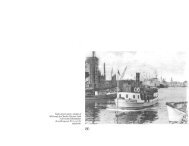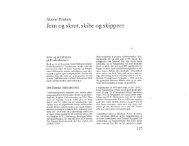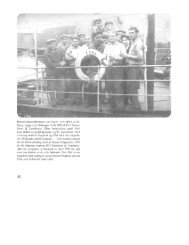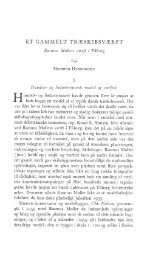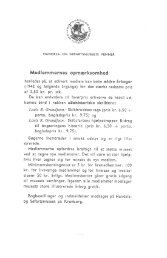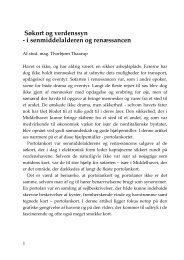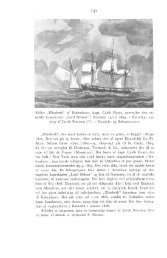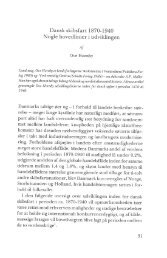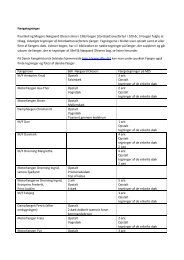Henning Henningsen: Rejs ud til Vagt! - Handels- og Søfartsmuseet
Henning Henningsen: Rejs ud til Vagt! - Handels- og Søfartsmuseet
Henning Henningsen: Rejs ud til Vagt! - Handels- og Søfartsmuseet
Create successful ePaper yourself
Turn your PDF publications into a flip-book with our unique Google optimized e-Paper software.
many brotherhoods on the ships of all nations. We can st<strong>ud</strong>y them best in the Nordic<br />
sources, where we see that the crew formed several smaller fellowships: for eating, for<br />
sleeping (often two people in one skin sleeping-bag), for rowing, for bailing, for the<br />
sharing of lockers, etc.<br />
Normal guard duties on board (e.g. look-out, guarding against enemies, port<br />
guard duty, anchor watch, etc.) were of course carried out even before the intro<br />
duction ofthe watch-system as such. We can see many examples of this in the Nordic<br />
sagas.<br />
The most valuable source of information about the start ofthe watch-system is the<br />
Norwegian Bjørkøret (Bjørkø Law) which dates from about 1170 but whose provi<br />
sions are probably older. An entire pre-watch-system has been developed here: the<br />
crew are divided into 4 watches who have 1. look-out duty, 2. mooring and anchor<br />
watch, 3. bailing duty, and 4. yard or sail duty. Each group is led by a »reidhumadhr«<br />
(quarter-master), and the exact position of his sleeping quarters in the ship is<br />
indicated. The assignment ofthe men to their watches follows their fixed piaces on<br />
the thwarts during rowing - they also had their sleeping quarters here - and one<br />
watch might for example begin in the stern and go aft on the starboard side, while<br />
another might begin by the mast on the port side and go forward to the forebody. In<br />
actual faet the watch-system here has clearly come a long way. What is missing here<br />
is primarily an exact measurement ofthe time intervals and an indication of these<br />
intervals by means of sound, in other words the hourglass and the ship's bell. That is<br />
why this source says nothing about the length of each watch; the relief ofthe watch<br />
could not have taken place at such regular intervals as later, even though it must be<br />
emphasized that human beings have a more or less accurate sense ofthe passage of<br />
time even without looking at a watch or clock. Similar watch-systems could probably<br />
have been used by other nations as well, but unfortunately the very limited amount of<br />
source material does not mention the faet.<br />
The watch is mentioned throughout the Middle Ages in some of the maritime<br />
legislation, especially as regards warships but also in the case of merchant ships.<br />
Italian, Spanish and English maritime laws mention the watch without any clear<br />
indication of whether they mean the old inherited (night-)watch, or whether the<br />
watch-system we are looking for has in faet been introduced. There are quite often<br />
references to the more or less harsh penalties for the presumptuous members ofthe<br />
watch who commit the most serious crime of all on board: sleeping while on duty.<br />
The first certain reference to the watch-system which we have found is in the Spanish<br />
law code Consolat de Mar in an extended version from the beginning ofthe 15th cen<br />
tury, where it clearly states that the skipper, immediately after setting sail, is duty<br />
bound to post the watches which are to keep watch on the ship, both in harbour and<br />
under sail. The watch on an Italian pilgrim's galley sailing from Venice to the Holy<br />
Land is described in 1483, and Columbus' diary from his first voyage in 1492-93<br />
112



